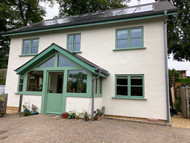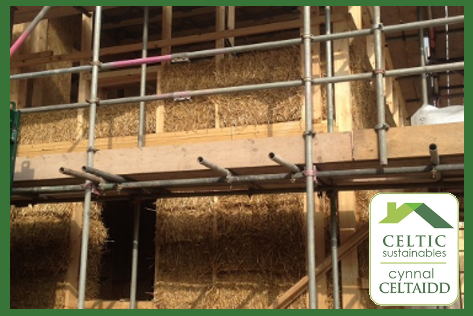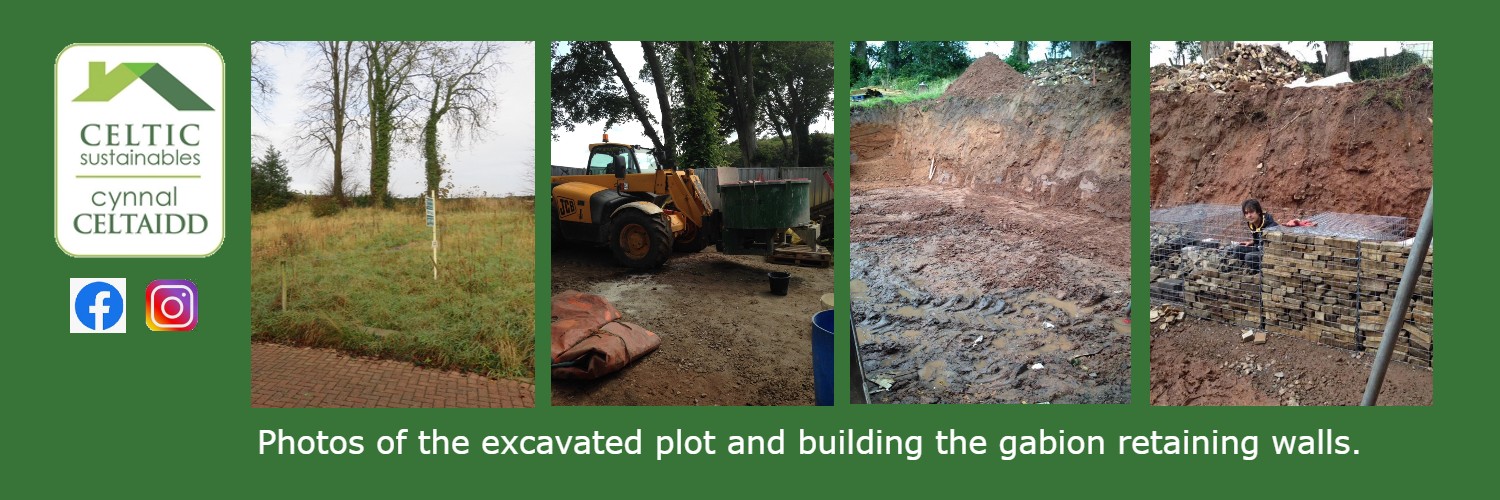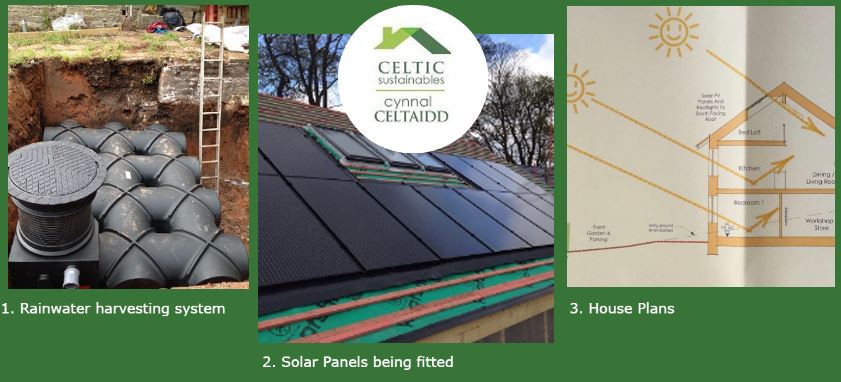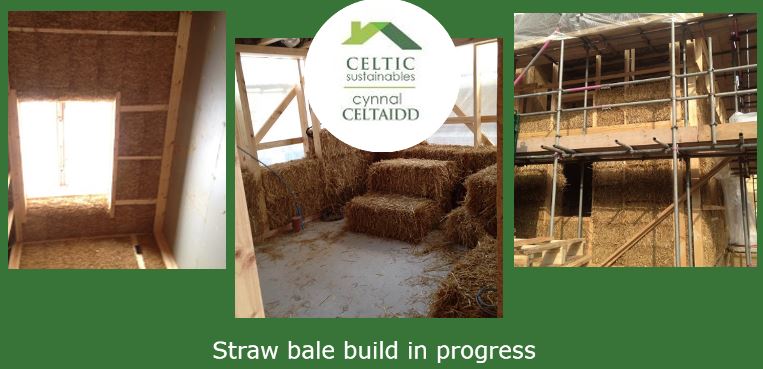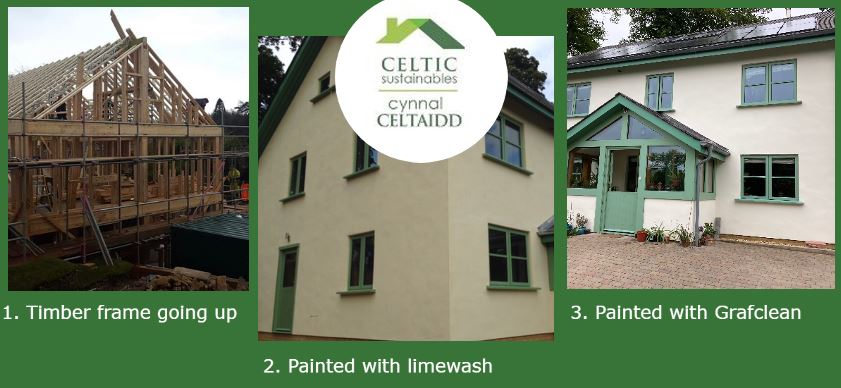A Straw Bale House Built with Clever Technologies
Posted by Sarah, Celtic Sustainables on 15th Aug 2023
In this article, we talk about straw bale houses and the numerous benefits they provide. Firstly, straw bale buildings are highly energy-efficient, providing excellent insulation and reducing heating and cooling costs. They also have a smaller carbon footprint than traditional homes, as straw is a renewable and readily available resource. Another benefit is their fire-resistant nature. We got talking to our customer Mike, who in 2018 started to build his own straw bale home. We highlight his personal experience, providing real-life evidence of the advantages of choosing this sustainable building method. Hopefully, this will inspire others to consider and adopt straw bale construction for their homes.
What is a Straw bale house?
Straw bale construction is a building method that uses bales of straw (commonly wheat, rice, rye, and oat straw) as structural elements and building insulation or both. Straw bales are made from a low-cost, renewable agricultural by-product that is otherwise wasted. Straw bales contain fewer toxins than conventional materials. They have a high insulating factor that lowers the cost of heating and cooling.
The use of straw bales is typically found in 'natural' building projects, they were used in construction 400 years ago in German, and straw cottages with thatched roofs have long been used in Europe and Asia. While historically, it has been a common form of building material in many parts of the world; it has received increased attention more recently due to its sustainable properties.
Straw bale house construction:
Straw bale building typically consists of stacking rows of bales, often on a footing or raised foundation. They used a moisture barrier between the bales and their supporting platform. The bales are fixed into place with either wood or surface mesh and then plastered with a lime-based formula or clay render.
Two different types of straw bale are in common use: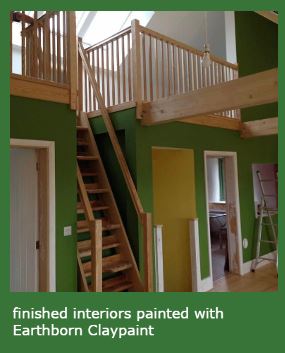
- Bales bound together with two strings.
- Bales are bound together with three strings (larger in all three dimensions).
The advantages of a straw-bale home include:
- A well-constructed bale home will be more fire-resistant than timber frame buildings.
- Low- impact being 100% Biodegradable at end of life (a straw bale house will last for over 100 years if properly constructed and maintained).
- Straw bale constructions have a low-embodied energy.
- Easy and cost-effective to install.
- The thickness of a straw bale wall can help reflect sunlight into a room and provide deep window seats.
- High insulation values can be achieved.
- Straw bale homes are made from low-cost products.
- They are beautiful.
Some of the disadvantages of straw bale construction include:
- Moisture and mould are significant risks. During the construction phase, buildings need to be protected from rain and water leakages into the body of the walls. If exposed to water, compressed straw may expand due to moisture absorption.
- Wall thickness means the overall usable floor space is smaller than conventional builds.
- Finding builders and construction workers familiar with the technique of straw bales can be tricky.
- The cost of transporting materials to the site if straw bales can’t be sourced locally.
- Straw dust (like other dusts) can be a lung irritant. If you have an allergy, wearing a breathing filter dust mask may be insufficient when moving or cutting the bales.
Do you need planning permission for a straw bale house?
If you plan on living in the straw-bale house, begin by consulting your local authority; the building must conform to building regulations.
Huffnpuff: a straw bale self-build
Mike and Bridget have wanted to build a straw bale house for the last twenty years and attended several builds to learn some of the required building skills.
Here we explore the new timber-frame home with straw bale insulation, airtightness & ventilation technologies, solar PV & rainwater harvesting. Huffnpuff is a new home near Brampton in Cumbria that combines modern Passivhaus technologies with traditional straw bale building methods. The three-bedroom home also includes a workshop and features a timber frame construction.
We contacted Mike to explore this innovative approach to sustainable building. To protect the exterior surfaces and provide long-lasting weather resistance, Grafclean Exterior paint has been used. This innovative paint features advanced technology that prevents dirt and pollution from adhering to the surface and helps maintain the home’s look for years to come. The finished result is a sustainable and visually stunning home built with the environment in mind.
They found a plot of land, about a third of an acre, south facing with all the services on site. Initially, they intended to build a smaller house but decided to build a two-storey house with a mezzanine level. With their ideas, it was designed by an eco-architect, Andrew Yates of Eco Architecture. They decided on a timber frame construction with straw bale insulation on the exterior and plastered with lime render.
Learning the know-how first
The owners, Mike, and Bridget are first-time self-builders, one of whom discovered straw building more than 20 years ago and has wanted to embark on a self-build project using straw ever since. They first gained hands-on experience at other straw bale builds in Cumbria, including the NationalTrust’s footprint building near Windermere a pig barn at Battery Farm and a writers’ retreat near Inverness.
A high level of airtightness
Mike aimed for the highest level of airtightness that could be reached to help reduce the heating needed and, therefore, the energy that will be used. Two membranes are under the floor, with eight inches of insulation between them. Two membranes are in the roof, and others are around the windows to avoid thermal bridging. Every possible access to cold air has been thought about. There are three layers of lime plaster inside and outside. The home will use a ventilation system like those found in Passivhaus buildings.
The build
Mike and Bridget first prepared the groundwork for the site and built the retaining walls themselves.
They also decided to employ contractors to make the build go faster. Sam Atkinson, a local experienced builder, carpenter, and plaster, swiftly got to work and used his JCB to mix and pump to spray lime onto the straw. Sam also made the windows and did the plumbing. The internal walls and ceilings were covered with OSB and internally filled with Warm cell (recycled newspaper). As well as doing all the carpentry themselves, they used second-hand tiles for the roof, which helped keep costs down.
They then got skilled contractors to finish the other tasks, from hanging doors to making stairs to the mezzanine level. Two bedrooms are on the ground floor, and one is upstairs, with the kitchen and mezzanine level room. The living room backs onto the garden as it is on a slope. They fitted solar panels on the south-facing roof, a Mechanical Ventilation Heat Recovery system (MVHR), and a 5000 litre rainwater harvester (for non-potable uses including water for the washing machine, toilets and watering the garden).
They then started painting the internal walls with Claypaint. Mike and Bridget liked Earthborn Claypaint’s ultra-matt finish for walls and ceilings. The beautiful range of traditional and contemporary colours are soothing and inspiring. Health and environmental benefits are unbeatable, too - Claypaint is virtually free of VOCs and other harmful emissions, odour free, totally oil free and highly breathable - a great paint for lime plaster. Being static resistant, Earthborn Claypaint reduces dust and allergen build-up. It is also easy to apply and has great covering power.
The external lime render was first painted with lime wash, but after two years, it started to look a bit worn and ready for another layer of lime wash. Mike did a bit of research online to see what other alternatives to lime wash there were, ideally something that would look good and last longer than lime wash and retain the breathability. That’s when he found Graphenstone Grafclean Exterior Paints. Graphenstone GrafClean mineral paint uses a revolutionary natural vegetable resin and graphene technology to create an outstanding modern mineral paint that can be used inside and outside. It has a beautiful matt finish and is very breathable; SD value: class 1, is certified for moisture control and is tough and long-lasting; it ticked all the boxes for Mike and Bridget! After testing the colour ‘clotted cream’, they worked out how much paint they’d need and got to work painting the exterior with Grafclean. They applied the paint with brushes, as they had to cut in around doorways, windows, and soffits. After applying two coats, they were impressed by the overall finish; it covered well and was pleasant to use.
“The house is great, and although it's not quite passive house standard, the bills are very low. We use very little heat to keep it at a constant temperature; the PV with the solar boost heats up the tank of water.” Mike Huffnpuff Home.
Mike and Bridget started the excavation and groundwork in August 2018. The main build was between March 2019, and they completed and moved into Huffnpuff by December 2019.
Products used:
#PaintDifferent #CelticSustainables #Graphenstone
If you’ve found this article helpful, please share it so someone else can benefit from seeing it. Don’t forget to share your achievements and before & after photos with us and friends; remember to tag us


